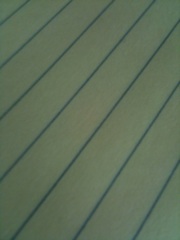I have kept journals for a very, very long time. I think it started in high school and tracks with my progress as a composer. I lacked the tools and talent to create the music that I imagined, so I wrote it out in prose and symbols. It wasn’t musical notiation in the traditional sense. There were lines and shapes. The visualization of imagined sounds. Much later I would study the notation of electronic music and see that I wasn’t alone. We rarely are.
My habit seems to be journaling more when I am composing less. It’s almost like switching muscle groups after a particularly rough workout. When the sounds aren’t coming, the words are. But as soon as the music returns, the journaling drops away. Since most of my journal entries during these musical dry spells are me moaning about how little I am producing I can only deduce that it’s a crutch of sorts to fill the idle time my mind and hands are having thrust upon them. It’s interesting that I’m posting as much on this blog as I am as I’ve been particularly productive lately.
It seems to me that journaling is an often ignored artform. There seems to be something of a resurgance in the popularity of journaling and there are many, many articles about how and why to journal floating around out there right now. There are the art journals that encourage us to scribble. Morning page journals that are set to wake up the creative mind and slowly brings us up to speed for the day. There are journals for tracking our habits. I prefer to keep all of these activities in the same place. I want a document.

I admit that I am more than mildly obsessed with documenting my creative work. This goes back to my first experiences with playing the guitar. Even at the age of 15 I could see that traditional notation left out a lot of information about how something was intended to be played. Yet recordings are subjective and leave out whatever plan there was for the performance. It’s only by combining the two that we get anything close to a complete story. As an avid improvisor, it’s often difficult to record something during my Monday night session and get back into it on Wednesday because I might not remember what my plan was. What key was this in? What tuning did I use? So there is an impetus to document these things simply for my personal information. But there’s more to it than that.
There’s always more to it.
My brother is a brilliant artist. He takes photographs, draws, paints, and pushes computers to do crazy things with images. His final product is a document. More importantly, it’s something someone could hang on the wall. Each of our parents has something on the wall that he made. It’s very difficult to put up a recording and it doesn’t make much sense to hang a score. And the score isn’t the music. I’m not saying that there is a sibling rivalry to this day over who has more of their creative garbage on mom or dad’s walls, but it was the first time I really noticed that the musical process produces few physical artifacts and saw the deficiencies of what documents are produced.
In writing this blog, I’d like to be able to bring people into what I do. My end game here is to develop a small audience of maybe 100 people to listen to what I do in any way they choose. After all, music is nothing without someone to hear it. But the question is, how does one showcase something that is developing when scraps and pieces of recordings and bits of paper don’t really mean anything? A painting in process is one thing. A score in progress is quite another. Or is it? Maybe a nightly dump of everything that was done over the course of a session would be an interesting thing. And maybe it would be a silly pile of flawed recordings and pictures of indecipherable notes. The project I’m working on right now doesn’t lend itself to this, but an experiment/exercise might be in order.
0 Comments.